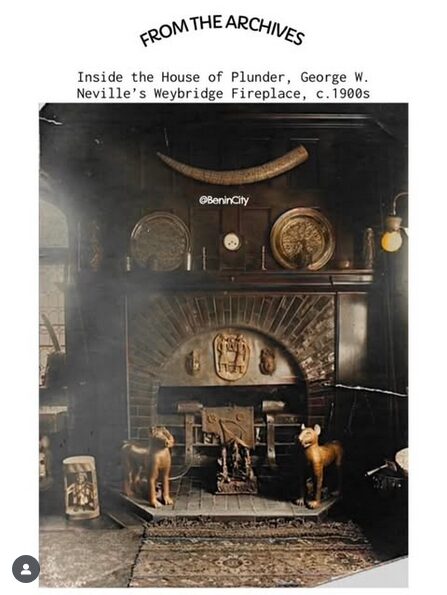A rare photograph of the Weybridge home of George W. Neville (1852–1929) offers a haunting glimpse into the private collection of a British official who once worked in Lagos for the Elder Dempster Shipping Company during the height of colonial expansion.
Neville’s collection, amassed after the 1897 Benin Expedition, included 128 objects taken from the Benin Kingdom. Following his death, these works were auctioned in London under the title: “Highly Important Bronzes, Ivory & Wood Carvings from the Walled City of Benin.”
A Quiet Museum of Imperial Possession
In the photograph, Neville’s living room resembles a private museum of colonial plunder. The hearth is flanked by bronze leopards, and above it rests a mounted ivory tusk, while the walls showcase plaques, carved heads, and altar pieces. Each object is a testament to Benin craftsmanship, royal symbolism, and metallurgical genius.
-
The bronze leopards originally symbolized royal power and divine guardianship in Benin royal courts.
-
The altar pieces and plaques depicted complex rituals, historical events, and the intricacies of courtly life, reflecting centuries of Edo artistic mastery.
Yet in Neville’s home, these sacred and symbolic objects were repurposed as decorative artifacts, stripped of their cultural and spiritual significance.
Where Are These Objects Today?
Over a century later, Neville’s collection remains dispersed across the globe:
-
The bronze leopards now reside in the National Museum, Lagos.
-
The plaque of Portuguese soldiers is housed at Musée du quai Branly, Paris.
-
The altar piece can be found in the Fowler Museum, Los Angeles.
-
Other pieces remain unaccounted for, silent witnesses to history’s imbalance.
Legacy and Influence
Despite displacement, Benin art continues to inspire globally, influencing modern sculpture, European modernism, digital art, and Afrofuturism. Works originally crafted in the Igun and Igbesamwan quarters of the ancient Benin Kingdom have shaped museums, designers, and artists worldwide, proving the enduring ingenuity of Edo artisans.
This photograph serves as a stark reminder of both the artistic brilliance of the Benin Kingdom and the historical injustices of colonial looting, encouraging conversations about restitution, cultural memory, and heritage preservation.
Credits: @BeninCity
Contextual Information By: Ben Hall, Tim Teuten, Hermione Waterfield, and Susan Kloman


Leave a Reply